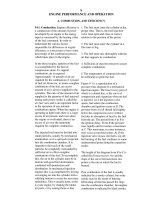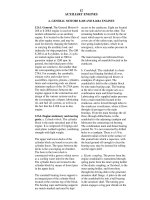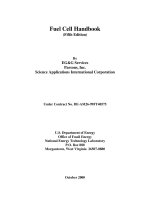Tài liệu Cutting Tools P11a docx
Bạn đang xem bản rút gọn của tài liệu. Xem và tải ngay bản đầy đủ của tài liệu tại đây (4.55 MB, 5 trang )
www.toolingandproduction.com
Chapter 11/Tooling & Production
1
2
Tooling & Production/Chapter 11
www.toolingandproduction.com
George Schneider, Jr. CMfgE
Professor Emeritus
Engineering Technology
Lawrence Technological University
Former Chairman
Detroit Chapter ONE
Society of Manufacturing Engineers
Former President
International Excutive Board
Society of Carbide & Tool Engineers
Lawrence Tech.- www.ltu.edu
Prentice Hall- www.prenhall.com
CHAPTER 11
Reaming and
Tapping
Metal Removal
Cutting-Tool Materials
Metal Removal Methods
Machinability of Metals
Single Point Machining
Turning Tools and Operations
Turning Methods and Machines
Grooving and Threading
Shaping and Planing
Hole Making Processes
Drills and Drilling Operations
Drilling Methods and Machines
Boring Operations and Machines
Reaming and Tapping
Multi Point Machining
Milling Cutters and Operations
Milling Methods and Machines
Broaches and Broaching
Saws and Sawing
Abrasive Processes
Grinding Wheels and Operations
Grinding Methods and Machines
Lapping and Honing
Upcoming Chapters
11.2 Reaming
Reaming has been defined as a ma-
chining process that uses a multi-
edged fluted cutting tool to smooth,
enlarge, or accurately size an existing
hole. Reaming is performed using the
same types of machines as drilling.
A reamer is a rotary cutting tool
with one or more cutting elements
used for enlarging to size and contour
a previously formed hole. Its principal
support during the cutting action is
obtained from the workpiece. A typical
reaming operation is shown in Figure
11.1.
11.2.1 Reamer Nomenclature
The basic construction and nomencla-
ture of reamers is shown in Figure
11.1 Introduction
Twist drills do not make accurately sized or good finish holes; a reamer of some
type is often used to cut the final size and finish. A reamer will not make the
original hole; it will only enlarge a previously drilled or bored hole. It will cut to
within +0.0005 inch of tool size and give finishes to 32 micro inches (u in).
Reamers are usually made of HSS although solid carbide and carbide tipped
reamers are made in many sizes and styles. Regular chucking reamers are made
in number and letter sizes, in fractional inch sizes, and in millimeter sizes. They
can be purchased ground to any desired diameter.
Screw threads are used for a variety of purposes and applications in the
machine tool industry. They are used to hold or fasten parts together (screws,
bolts, and nuts), and to transmit motion (the lead screw moves the carriage on an
engine lathe). Screw threads are also used to control or provide accurate
movement (the spindle on a micrometer), and to provide a mechanical advantage
(a screw jack raises heavy loads).
When defining a screw thread, one must consider separate definitions for an
external thread (screw or bolt) and an internal thread (nut).
An external thread is a cylindrical piece of material that has a uniform helical
groove cut or formed around it. An internal thread is defined as a piece of
material that has a helical groove around the interior of a cylindrical hole. This
chapter will discuss internal threads and tapping, the operation that produces
such threads.
0.004 to 0.032 in.
Cutting
11.2. This shows the most frequently
used style for holes up to 1 inch, called
a chucking reamer.
Solid reamers do almost all their
cutting with the 45 degree chamfered
FIGURE 11.1: A typical reaming opera-
tion removes 0.004 to 0.032 in. of stock.
www.toolingandproduction.com
Chapter 11/Tooling & Production
3
Chap. 11: Reaming and TappingChap. 11: Reaming and Tapping
front end. The flutes guide the reamer
and slightly improve the finish. There-
fore, reamers should not be used for
heavy stock removal.
Axis: The axis is the imaginary
straight line which forms the longitu-
dinal centerline of a reamer, usually
established by rotating the reamer be-
tween centers.
Back Taper: The back taper is a
slight decrease in diameter, from front
to back in the flute length of reamers.
Body: The body is: 1) The fluted
full diameter portion of a reamer, in-
clusive of the chamfer, starting taper
and bevel. 2) The principal supporting
member for a set of reamer blades,
usually including the shank.
Chamfer: The chamfer is the angu-
lar cutting portion at the entering end
of a reamer.
Chamfer Length: The chamfer
length is the length of the chamfer
measured parallel to the axis at the
cutting edge.
Chamfer Relief Angle: The cham-
fer relief angle is the axial relief angle
at the outer corner of the chamfer. It is
measured by projection into a plane
tangent to the periphery at the outer
corner of the chamfer.
Clearance: Clearance is the space
created by the relief behind the cutting
edge or margin of a reamer.
Cutting Edge: The cutting edge is
the leading edge of the land in the
direction of rotation for cutting.
Flutes: The flutes are longitude
channels formed in the body of the
reamer to provide cutting edges, per-
mit passage of chips, and allow cutting
fluid to reach the cutting edges.
Flute Length: Flute length is the
length of the
flutes not includ-
ing the cutter
sweep.
Land: The
land is the sec-
tion of the
reamer between
adjacent flutes.
Margin: The
margin is the un-
relieved part of
the periphery of
the land adjacent
to the cutting
edge.
Neck: The
neck is a section
of reduced diam-
eter connecting
shank to body, or connecting other
portions of the reamer.
Overall Length: The overall length
is the extreme length of the complete
reamer from end to end, but not includ-
ing external centers or expansion
screws.
Shank: The shank is the portion of
the reamer by which it is held and
driven.
Straight Shank: A straight shank is
a cylindrical shank.
Taper Shank: A taper shank is a
shank made to fit a specified (conical)
taper socket.
11.2.2 Types of Reamers
Reamers are made with three shapes of
flutes and all are standard.
Straight Flute: Straight flute ream-
ers are satisfactory for most work and
the least expensive, but should not be
used if a keyway or other interruption
is in the hole.
Right-hand Spiral: Right-hand spi-
ral fluted reamers give
freer cutting action and
tend to lift the chips out
of the hole. They should
not be used on copper or
soft aluminum because
these reamers tend to pull
down into the hole.
Left-hand Spiral: Left-hand spiral
fluted reamers require slightly more
pressure to feed but give a smooth cut
and can be used on soft, gummy mate-
rials, since they tend to be pushed out
of the hole as they advance. It is not
wise to use these in blind holes, be-
cause they push the chips down into
the hole.
All reamers are used to produce
smooth and accurate holes. Some are
turned by hand, and others use ma-
chine power. The method used to iden-
tify left hand and right hand reamers is
shown in Figure 11.3.
Machine Reamers
Machine reamers are used on both
drilling machines and lathes for rough-
ing and finishing operations. Machine
reamers are available with tapered or
straight shanks, and with straight or
helical flutes. Tapered shank reamers
(see Fig. 11.4) fit directly into the
spindle, and the straight shank reamer,
generally called the chucking reamer,
fits into a drill chuck.
Rose Reamers: Rose reamers are
machine reamers that cut only on a 45-
degree chamfer (bevel) located on the
end. The body of the rose reamer
tapers slightly (about 0.001 inch per
inch of length) to prevent binding dur-
ing operation. This reamer does not
cut a smooth hole and is generally used
to bring a hole to a few thousands
undersize. Because the rose reamer
machines a hole 0.001 to 0.005 inches
under a nominal size, a hand reamer is
used to finish the hole to size. All
Overall length (OAL)
Shank length
Shank
Straight or taper
Flute length
Cutting edge
Flutes
Chamfer
angle 45
°
1
16
*
*
Chamfer
length
Actual
diameter
Chamfer
relief
*Most reamers are made to these dimensions
Actual
size
Cutting edge
Zero rake
Heel
Flute
Land width
Margin
Relief
angle
Radial
rake angle
Zero rake ri
ght-hand cut Positive rake right-hand cut
Slopes
to left
Slopes
to right
Left-hand helix,
right-hand cut
Right-hand helix,
right-hand cut
FIGURE 11.2: Construction and nomenclature of a straight-fluted
machining reamer.
FIGURE 11.3: Method of identifying
left-hand and right-hand reamers.
FIGURE 11.4: Carbide-tipped straight-fluted tapered-
shank reamer. (Courtesy: Morse Cutting Tools)
4
Tooling & Production/Chapter 11
www.toolingandproduction.com
Chap. 11: Reaming and TappingChap. 11: Reaming and Tapping
hand reamers have a square shank and
cannot be used and operated with ma-
chine power.
Fluted Reamers: Fluted reamers
are machine reamers used to finish
drilled holes. This type of reamer
removes smaller portions of metal
compared to the rose reamer. Fluted
reamers have more cutting edges than
rose reamers and therefore cut a
smoother hole. Fluted reamers cut on
the chamfered end as well as the sides.
They are also available in solid carbide
or have carbide inserts for cutting
teeth.
Shell Reamers: Shell reamers (Fig.
11.5) are made in two parts: the
reamer head and the arbor. In use, the
reamer head is mounted on the arbor.
The reamer head is available with ei-
ther a rose or flute type, with straight
or helical flutes. The arbor is available
with either straight or tapered shank.
The shell reamer is considered eco-
nomical, because only the reamer is
replaced when it becomes worn or
damaged.
Hand Reamers
Hand reamers are finishing reamers
distinguished by the square on their
shanks (see Fig. 11.6). They are turned
by hand with a tap wrench that fits
over this square (see Fig. 11.7) this
type of reamer cuts only on the outer
cutting edges. The end of the hand
reamer is tapered slightly to permit
easy alignment in the drilled hole. The
length of taper is usu-
ally equal to the
reamer’s diameter.
Hand reamers must
never be turned by ma-
chine power, and must
be started true and
straight. They should
never remove more
than 0.001 to 0.005 inches of material.
Hand reamers are available from 1/8 to
over 2 inches in diameter and are
generally made of carbon steel or high-
speed steel.
Taper Hand Reamers: Taper hand
reamers are hand reamers made to
ream all standard size tapers. They are
made for both roughing and finishing
tapered holes. Similar to the straight
hand reamer, this taper should be used
carefully, and never with machine
power.
Adjustable Reamers: (Fig. 11.8a)
Adjustable reamers are used to pro-
duce any size hole within the range of
the reamer. Their size is adjusted by
sliding the cutting blades to and from
the shank. The two adjusting nuts
located at each end of the blades move
these blades. Adjustable hand reamers
are available in sizes from 1/4 to over 3
inches diam-
eters. Each
reamer has ap-
proximately 1/
64-inch adjust-
ment above and
below its nomi-
nal diameter.
Expansion
Hand Ream-
ers: (Fig.11.8b)
Expansion hand
reamers are like
the adjustable reamers, but have a lim-
ited range of approximately 0.010 inch
adjustment. Expansion reamers have
an adjusting screw at the end of the
reamer. When turned, this adjusting
screw forces a tapered plug inside the
body of the reamer, expanding its di-
ameter. Expansion reamers are also
available as machine reamers.
Care of Reamers: Because reamers
are precision finishing tools, they
should be used with care;
* Reamers should be stored in sepa-
rate containers or spaced in the tooling
cabinet to prevent damage to the cut-
ting edges.
* Cutting fluids must always be used
during reaming operations, except
with cast iron.
* A reamer must never be turned
backward or the cutting edges will be
dulled.
* Any burrs or nicks on the cutting
edges must be removed with an oil-
stone to prevent cutting oversize holes.
11.2.3 Operating Conditions
In reaming speed and feed are im-
portant; stock removal and alignment
must be considered in order to produce
chatter free holes.
Reaming Speeds: Speeds for ma-
chine reaming may vary considerably
depending in part on the material to be
reamed, type of machine, and required
finish and accuracy. In general most
machine reaming is done at about 2/3
the speed used for drilling the same
material.
Reaming Feeds: Feeds for reaming
are usually much higher than those
used for drilling, often running 200 to
300 percent of drill feeds. Too low a
feed may result in excessive reamer
wear. At all times it is necessary that
the feed be high enough to permit the
reamer to cut rather than to rub or
burnish. Too high a feed may tend to
reduce the accuracy of the hole and
may also lower the quality of the fin-
ish. The basic idea is to use as high a
FIGURE 11.5: Shell reamer arbor with two reamer heads, one
HSS and the other carbide tipped. (Courtesy: Morse Cutting
Tools)
FIGURE 11.6: Left-hand-helix hand
reamer, square-shanked hand ream-
ers cannot be power driven. (Courte-
sy: Cleveland Twist Drill Greenfield
Industries)
FIGURE 11.7: Tap wrenches are also used to hold hand reamers to finish drilled
holes. (Courtesy: Cleveland Twist Drill Greenfield Industries)
FIGURE 11.8: (a) Adjustable hand reamer. (b) A square-
shanked expansion reamer. (Courtesy: Morse Cutting
Tools)
www.toolingandproduction.com
Chapter 11/Tooling & Production
5
Chap. 11: Reaming and TappingChap. 11: Reaming and Tapping
feed as possible and still produce the
required finish and accuracy.
Stock to be Removed: For the same
reason, insufficient stock for reaming
may result in a burnishing rather than a
cutting action. It is difficult to gener-
alize on this phase as it is tied in
closely with type of material, feed,
finish required, depth of hole, and chip
capacity of the reamer. For machine
reaming, .010 inch on a 1/4-inch hole,
.015 inch on a 1/2 inch hole, up to .025
inch on a 1-1/2 inch hole seems a good
starting point. For hand reaming,
stock allowances are much smaller,
partly because of the difficulty in forc-
ing the reamer through greater stock.
A common allowance is .001 inch to
.003 inch.
Alignment: In the ideal reaming
job, the spindle, reamer, bushing, and
hole to be machined are all in perfect
alignment. Any variation from this
tends to increase reamer wear and de-
tracts from the accuracy of the hole.
Tapered, oversize, or bell-mouthed
holes should call for a check of align-
ment. Sometimes the bad effects of
misalignment can be reduced through
the use of floating or adjustable hold-
ers. Quite often if the user will grind a
slight back taper on the reamer it will
also be of help in overcoming the
effects of misalignment.
Chatter: The presence of chatter
while reaming has a very bad effect on
reamer life and on the finish in the hole.
Chatter may be the result of one of
several causes, some of which are listed:
* Excessive speed.
* Too much clearance on reamer.
* Lack of rigidity in jig or machine.
* Insecure holding of work.
* Excessive overhand of reamer or
spindle.
* Too light a feed.
Correcting the cause can materially
increase both reamer life and the qual-
ity of the reamed holes.
In reaming the emphasis is usually
on finish, and a coolant is normally
chosen for this purpose rather than for
cooling.
11.2.4 Reaming Operations
Reaming operations can be per-
formed on lathes, drills, and machin-
ing centers.
Lathe Reaming: Reaming on a
lathe can only be done by holding the
reamer in the tail stock position
either in a drill chuck for straight
shank reamers, or directly in the
tail stock quill for tapered shank
reamers ( see Fig. 11.4). Work to
be reamed can either be held in a
chuck or mounted onto the face-
plate. In case of a turret lathe, the
reamer can only be used in the
hex turret.
Sometimes reamers are held in
‘floating’ holders in the tailstock.
These holders allow the reamer to
center itself on the previously
drilled hole. Deep holes (over
three times the diameter of the
drill) tend to ‘run out’. The
reamer will not correct this condi-
tion and the hole must be bored if
alignment is important.
Drill Press Reaming: Reaming on
a drill press also requires the reamer to
be held in the spindle with a drill
chuck for straight shank machining
reamers, or directly in the spindle for
tapered shank reamers (see Fig. 11.4).
The work to be reamed is usually held
in a vise and centered on the drill
table.
Reaming on a lathe is performed by
rotating the work with a stationary
reamer, while reaming on a drill press
is performed with a rotating reamer
and a stationary workpiece. ‘Floating’
heads can be used on drill presses as
well as lathes.
Machining Center Reaming:
Reaming on a machining center is
common. Reamers are usually held in
the hex turret or in an automatic tool
magazine. Set-ups are usually more
complicated while speeds and feeds
are preprogrammed.
11.3 Tapping
Tapping has been defined as: A pro-
cess for producing internal threads us-
ing a tool (tap) that has teeth on its
periphery to cut threads in a predrilled
hole. A combined rotary and axial
relative motion between tap and
workpiece forms threads. A typical
Shank diameter
Size of
square
Shank length
Thread length
Axis
Length
of square
Overall length
Chamfer
90º
Thread lead
angle
Point
diameter
Core diameter
Flute
External center
Internal center
Chamfer
relief
Angle of thread
Base of thread
Basic root
Flank
Basic pitch diameter
Basic minor diameter
Basic
height of
thread
Pitch
Basic crest
Tap crest
Basic
major
diameter
Min. tap
major
diameter
Max. tap
major
diameter
FIGURE 11.9: A typical automated tapping
operation with self-reversing unit. (Courtesy:
Tapmatic Corp.)
FIGURE 11.10: Tap and thread nomenclature.









